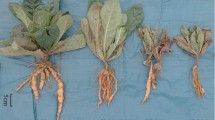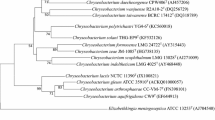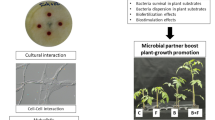Abstract
Collimonas sp. IS343, isolated from an organically-farmed arable soil and characterized as a broad-range oligotrophic bacterium, was shown to degrade chitin and to suppress R. solani mycelium growth under in vitro conditions at high and low carbon availabilities. In contrast to C. fungivorans Ter331, strain IS343 did not respond with an increase in growth rate to higher carbon levels in liquid medium, it reached higher cell numbers in carbon-poor media and it showed better survival in bulk soil. Therefore, it was concluded that strain IS343 cells are better adapted to circumstances of low carbon availability as present in bulk soils than strain Ter331 cells. Further, strain IS343 cells were more suppressive towards R. solani than strain Ter331 cells in vitro. When introduced into soil, strain IS343 cells delayed disease development caused by R. solani AG2-2IIIB in sugar beet plants. These results suggest that strain IS343 cells are able to tentatively suppress R. solani AG2-2IIIB mycelium growth in soil. Potential mechanisms behind the observed suppressive effects can be competition for available nutrients between strain IS343 cells and R. solani mycelium in soil or the production of chitinase as shown for this and other Collimonas species.



Similar content being viewed by others
References
Campbell, C. L., & Madden, L. V. (1990). Introduction to plant disease epidemiology. New York: John Wiley & Sons. 532 pp.
De Boer, W., Klein Gunnewiek, P. J. A., Lafeber, P., Janse, J. D., Spit, B. E., & Woldendorp, J. W. (1998). Anti-fungal properties of chitinolytic dune soil bacteria. Soil Biology and Biochemistry, 30, 193–203.
De Boer, W., Klein Gunnewiek, P. J. A., Kowalchuk, G. A., & Van Veen, J. A. (2001). Growth of chitinolytic dune soil β-subclass proteobacteria in response to invading fungal hyphae. Applied and Environmental Microbiology, 67, 3358–3362.
De Boer, W., Leveau, J. H. J., Kowalchuk, G. A., Klein Gunnewiek, P. J. A., Abeln, E. C. A., Figge, M. J., et al. (2004). Collimonas fungivorans gen. nov. sp. nov. a chitinolytic soil bacterium with the ability to grow on living fungal hyphae. International Journal of Systematic and Evolutionary Microbiology, 54, 857–864.
Demoling, F., Figueroa, D., & Baath, E. (2007). Comparison of factors limiting bacterial growth in different soils. Soil Biology and Biochemistry, 39, 2485–2495.
Fierer, N., Bradford, M. A., & Jackson, R. B. (2007). Toward an ecological classification of soil bacteria. Ecology, 88, 1354–1364.
Grünwald, N. J., Hu, S., & Van Bruggen, A. H. C. (2000). Short-term cover crop decomposition in organic and conventional soils; Characterization of soil C, N, microbial and plant pathogen dynamics. European Journal of Plant Pathology, 106, 37–50.
He, M., Ma, W., Tian, G., Blok, W., Khodzaeva, A., Zelenev, V. V., et al. (2010). Daily changes of infections by Pythium ultimum after a nutrient impulse in organic versus conventional soils. Phytopathology, 100, 593–600.
He, M., Tian, G., Semenov, A. M., & Van Bruggen, A. H. C. (2012). Short-term fluctuations of sugar-beet damping-off by Pythium ultimum in relation to changes in bacterial communities after organic amendments to two soils. Phytopathology, 102, 413–420.
Hiddink, G. A., van Bruggen, A. H. C., Termorshuizen, A. J., Raaijmakers, J. M., & Semenov, A. V. (2005). Effect of organic management of soils on suppressiveness to Gaeumannomyces graminis var. tritici and its antagonist, Pseudomonas fluorescens. European Journal of Plant Pathology, 113, 417–435.
Höppener-Ogawa, S., Leveau, J. H. J., Smant, W., Van Veen, J. A., & De Boer, W. (2007). Specific detection and real-time PCR quantification of potentially mycophagous bacteria belonging to the genus Collimonas in different soil ecosystems. Applied and Environmental Microbiology, 73, 4191–4197.
Höppener-Ogawa, S., De Boer, W., Leveau, J. H. J., Van Veen, J. A., De Brandt, E., Vanlaere, E., et al. (2008). Collimonas arenae sp. nov. and Collimonas pratensis sp. nov. isolated from (semi-)natural grassland soils. International Journal of Systematic and Evolutionary Microbiology, 58, 414–419.
Höppener-Ogawa, S., Leveau, J. H. J., Van Veen, J. A., & De Boer, W. (2009). Mycophagous growth of Collimonas bacteria in natural soils, impact on fungal biomass turnover and interactions with mycophagous Trichoderma fungi. ISME Journal, 3, 190–198.
Hu, S., van Bruggen, A. H. C., Wakeman, R. J., & Grunwald, N. J. (1997). Microbial suppression of in vitro growth of Pythium ultimum and disease incidence in relation to soil C and N availability. Plant and Soil, 195, 43–52.
Hu, S. J., Van Bruggen, A. H. C., & Grünwald, N. J. (1999). Dynamics of bacterial populations in relation to carbon availability in a residue-amended soil. Applied Soil Ecology, 13, 21–30.
Ikeda, S., Omura, T., Ytow, N., Komaki, H., Minamisawa, K., Ezura, H., et al. (2006). Microbial community analysis in the rhizosphere of a transgenic tomato that overexpresses 3-hydroxy-3-methylglutaryl Coenzyme A Reductase. Microbes and Environments, 21, 261–271.
Ingram, C., & Westpheling, J. (1995). The glucose kinase gene of Streptomyces coelicolor is not required for glucose repression of the chi63 promoter. Journal of Bacteriology, 177, 3587–3588.
Kamilova, F., Leveau, J. H. J., & Lugtenberg, B. (2007). Collimonas fungivorans, an unpredicted in vitro but efficient in vivo biocontrol agent for the suppression of tomato foot and root rot. Environmental Microbiology, 9, 1597–1603.
Kuznetsov, S. I., Dubinina, G. A., & Lapteva, N. A. (1979). Biology of oligotrophic bacteria. Annual Review of Microbiology, 33, 377–387.
Lavrent’eva, E. V., Semenov, A. M., Zelenev, V. V., Chzhun, Y., Semenova, E. V., Semenov, V. M., et al. (2009). Daily dynamics of cellulase activity in arable soils depending on management practices. Eurasian Soil Science, 42, 885–893.
Leveau, J. H. J., Uroz, S., & De Boer, W. (2009). The bacterial genus Collimonas: mycophagy, weathering and other adaptive solutions to life in oligotrophic soil conditions. Environmental Microbiology, 12, 281–292.
Männistö, M. K., & Häggblom, M. M. (2006). Characterization of psychrotolerant heterotrophic bacteria from Finnish Lapland. Systematic and Applied Microbiology, 29, 229–243.
Monod, J. (1949). The growth of bacterial cultures. Annual Review of Microbiology, 3, 371–394.
Offre, P., Pivato, B., Siblot, S., Gamalero, E., Corberand, T., Lemanceau, P., et al. (2007). Identification of bacterial groups preferentially associated with mycorrhizal roots of Medicago truncatula. Applied and Environmental Microbiology, 73, 913–921.
Opelt, K., & Berg, G. (2004). Diversity and antagonistic potential of bacteria associated with bryophytes from nutrient-poor habitats of the Baltic Sea coast. Applied and Environmental Microbiology, 70, 6569–6579.
Postma, J., Schilder, M. T., Bloem, J., & Van Leeuwen-Haagsma, W. K. (2008). Soil suppressiveness and functional diversity of the soil microflora in organic farming systems. Soil Biology and Biochemistry, 40, 2394–2406.
Postma, J., Nijhuis, E. H. M., & Yassin, A. F. (2010). Genotypic and phenotypic variation among Lysobacter capsici strains isolated from Rhizoctonia suppressive soils. Systematic and Applied Microbiology, 33, 232–235.
Pruesse, E., Quast, C., Knittel, K., Fuchs, B. M., Ludwig, W., et al. (2007). SILVA: a comprehensive online resource for quality checked and aligned ribosomal RNA sequence data compatible with ARB. Nucleic Acids Research, 35, 7188–7196.
Rademaker, J. L. W., Louws, F. J., & De Bruijn, F. J. (1997). Characterization of the diversity of ecologically important microbes by rep-PCR genomic fingerprinting. In A. D. L. Akkermans, J. D. Van Elsas, & J. D. de Bruijn (Eds.), Molecular microbial ecology manual (pp. 1–26). Dordrecht: Kluwer Academic Publishers. Supplement 3, chapter 3.4.3.
Schmidt, M., Priemé, A., & Stougaard, P. (2006). Bacterial diversity in permanently cold and alkaline ikaite columns from Greenland. Extremophiles, 10, 551–562.
Semenov, A. M. (1991). Physiological bases of oligotrophy of microorganisms and the concept of microbial community. Microbial Ecology, 22, 239–247.
Semenov, A. M., Van Bruggen, A. H. C., & Zelenev, V. V. (1999). Moving waves of bacterial populations and total organic carbon along roots of wheat. Microbial Ecology, 37, 116–128.
Semenov, A. V., Franz, E., Van Overbeek, L., Termorshuizen, A. J., & Van Bruggen, A. H. C. (2008). Estimating the stability of Escherichia coli O157:H7 survival in manure amended soils with different management histories. Environmental Microbiology, 10, 1450–1459.
Semenov, A. V., Van Overbeek, L., & Van Bruggen, A. H. C. (2009). Percolation and survival of E. coli O157H7 and Salmonella enterica serovar Typhimurium in soil amended with contaminated dairy manure or slurry. Applied and Environmental Microbiology, 75, 3206–3215.
Senechkin, I. V., Speksnijder, A. G. C. L., Semenov, A. M., Van Bruggen, A. H. C., & Van Overbeek, L. S. (2010). Isolation and partial characterization of bacterial strains on low organic carbon medium from soils fertilized with different organic amendments. Microbial Ecology, 60, 829–839.
Uroz, S., Calvaruso, C., Turpault, M. P., Pierrat, J. C., Mustin, C., & Frey-Klett, P. (2007). Effect of the mycorrhizosphere on the genotypic and metabolic diversity of the bacterial communities involved in mineral weathering in a forest soil. Applied and Environmental Microbiology, 73, 3019–3027.
Uroz, S., Calvaruso, C., Turpault, M.-P., & Frey-Klett, P. (2009). Mineral weathering by bacteria: ecology, actors and mechanisms. Trends in Microbiology, 17, 378–387.
Van Bruggen, A. H. C., & Semenov, A. M. (1999). A new approach to the search for indicators of root disease suppression. Australasian Plant Pathology, 28, 4–10.
Van Bruggen, A. H. C., & Termorshuizen, A. J. (2003). Integrated approaches to root disease management in organic farming systems. Australasian Plant Pathology, 32, 141–156.
Van Bruggen, A. H. C., Semenov, A. M., & Zelenev, V. V. (2000). Wave-like distributions of microbial populations along an artificial root moving through soil. Microbial Ecology, 40, 250–259.
Van Bruggen, A. H. C., Semenov, A. M., & Zelenev, V. V. (2002). Wave-like distributions of infections by an introduced and naturally occurring root pathogen along wheat roots. Microbial Ecology, 44, 30–38.
Van Bruggen, A. H. C., Semenov, A. M., Van Diepeningen, A. D., De Vos, O. J., & Blok, W. J. (2006). Relation between soil health, wave-like fluctuations in microbial populations, and soil-borne plant disease management. European Journal of Plant Pathology, 115, 105–122.
Van Diepeningen, A. D., de Vos, O. J., Zelenev, V. V., Semenov, A. M., & Van Bruggen, A. H. C. (2005). DGGE fragments oscillate with or counter to fluctuations of cultivable bacteria along wheat roots. Microbial Ecology, 50, 506–517.
Van Diepeningen, A. D., De Vos, O. J., Korthals, G. W., & Van Bruggen, A. H. C. (2006). Effects of organic versus conventional management on chemical and biological parameters in agricultural soils. Applied Soil Ecology, 31, 120–135.
Van Elsas, J. D., & Van Overbeek, L. S. (1993). Bacterial responses to soil stimuli. In S. Kjelleberg (Ed.), Starvation in bacteria. New York: Plenum Press.
Van Elsas, J. D., Trevors, J. T., & Wellington, E. M. H. (1997). Modern soil microbiology. New York: Marcel Dekker Inc.
Van Overbeek, L. S., Eberl, L., Givskov, M., Molin, S., & Van Elsas, J. D. (1994). Induced stress resistance in Pseudomonas fluorescens residing in soil. Applied and Environmental Microbiology, 61, 4202–4208.
Van Overbeek, L. S., Senechkin, I. V., & Van Bruggen, A. H. C. (2012). Variation in microbial responses and Rhizoctonia solani AG2-2IIIB growth in soil under different organic amendment regimes. Canadian Journal of Plant Pathology, 34, 268–276.
Van Veen, J. A., Van Overbeek, L. S., & Van Elsas, J. D. (1997). Fate and activity of microorganisms introduced into soil. Microbiology and Molecular Biology Reviews, 61, 121–135.
Whang, K., & Hattori, T. (1988). Oligotrophic bacteria from rendzina forest soil. Antonie Van Leeuwenhoek, 54, 19–36.
Zelenev, V. V., Van Bruggen, A. H. C., & Semenov, A. M. (2000). “BACWAVE”, a spatial-temporal model for traveling waves of bacterial populations in response to a moving carbon source in soil. Microbial Ecology, 40, 260–272.
Zelenev, V. V., Van Bruggen, A. H. C., & Semenov, A. M. (2005a). Short-term wave-like dynamics of bacterial populations in response to nutrient input from fresh plant residues. Microbial Ecology, 49, 83–93.
Zelenev, V. V., Van Bruggen, A. H. C., & Semenov, A. M. (2005b). Modeling wave-like dynamics of oligotrophic and copiotrophic bacteria along wheat roots in response to nutrient input from a growing root tip. Ecological Modelling, 188, 404–417.
Zelenev, V. V., Van Bruggen, A. H. C., Leffelaar, P. A., Bloem, J., & Semenov, A. M. (2006). Oscillating dynamics of bacterial populations and their predators in response to fresh organic matter added to soil: the simulation model ‘BACWAVE-WEB’. Soil Biology and Biochemistry, 38, 1690–1711.
Acknowledgments
This research was part of the Ecogenomics program which was sponsored by the Dutch National Genomics Initiative and the basic research program on sustainable agriculture (KB4) funded by the Dutch Ministry of Agriculture, Nature and Food Safety. We would like to thank Pieter Kastelein for his assistance with the plant-soil microcosm experiments.
Author information
Authors and Affiliations
Corresponding author
Additional information
First and second authors contributed equally to the manuscript.
Rights and permissions
About this article
Cite this article
Senechkin, I.V., van Overbeek, L.S., Er, H.L. et al. Interaction of Collimonas strain IS343 with Rhizoctonia solani at low carbon availability in vitro and in soil. Eur J Plant Pathol 136, 789–802 (2013). https://doi.org/10.1007/s10658-013-0207-6
Accepted:
Published:
Issue Date:
DOI: https://doi.org/10.1007/s10658-013-0207-6




